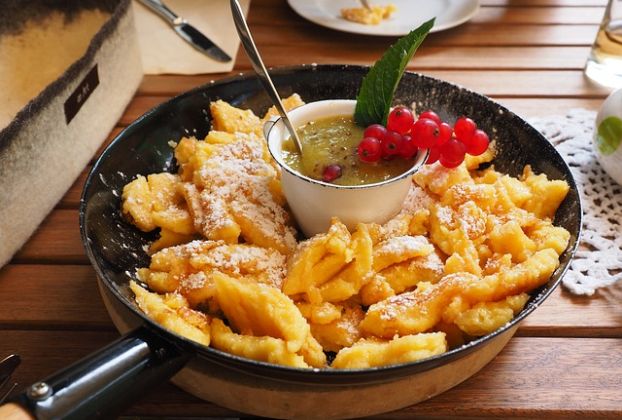Accidentally I found a recipe for a royal dessert, and thought it would be fun to collect some links to recipes here. Over the centuries lots of food was named after royals or is regarded as the favourite dish of a royal. How did I end up with so much cakes and desserts! Just have to reveal I really love sweet stuff – better not eat it too much though. Maybe an idea for Christmas? Not that I am going to cook myself …
Alexandertorte (Alexander Cake) – Created it is said to commemorate a visit of Czar Alexander III of Russia in Riga, nowadays Latvia. Another story is that it was named after Czar Alexander I of Russia, created by Swiss pastry chefs in Helsinki, nowadays Finland, when the he visited the city in 1818.
Apple Charlotte – A dessert apparently named after Queen Charlotte, the wife of King George III of Grat Britain, who was a supporter of apple growers. The recipe itself however already dates back to 15th-century England.
Banana flan – apparently the favourite of Prince William, The Duke of Cambridge and his brother Prince Harry of Wales (at least when they were younger).
Battenberg cake – The cake is supposedly named in honour of the marriage of Princess Victoria, a granddaughter of Queen Victoria of Great Britain, to Prince Louis of Battenberg in 1884. The family name Battenberg was changed into Mountbatten in the Great War. The four squares of the cake represent the four Battenberg princes Louis, Alexander, Henry and Francis Joseph.
Café Maria Theresia – Drink named after Empress Maria Theresia of Austria.
Charlotte Russe – I found recipes with a variety of fillings online. The dessert was invented by the French chef Marie-Antoine Carême and named in honour of Princess Charlotte, daughter of King George IV of Great Britain, and/or the Russian Czar Alexander.
Consommé Princess Alice – Named for Princess Alice, Countess of Athlone, one of Queen Victoria of Great Britain’s granddaughters.
Coronation chicken – Created on the occasion of the coronation of Queen Elizabeth II of Great Britain in 1953. I had it only as a kind of cold salad, but it tasts quite good.
Esterházy rostelyos (Esterhazy steak) – Likely named after a 19th century Prince Esterházy.
Gungjung Tteokbokki (Korean Royal court stir fried rice cakes) – This snack (also appetizer or light meal) was originally served in the royal court during the Joseon dynasty (1392-1910).
Kaiser rolls (Kaisersemmel) – Probably named after Emperor Franz Joseph I of Austria. Although Wikipedia says they were made by a Viennese baker around 1487 for the Holy Roman Emperor Friedrich III.

Kaiserschmarrn (Emperor’s Trifle) – Can be eaten as main course and as a dessert. The shredded pancake was named after the Austrian Emperor (Kaiser) Franz Joseph I.
Prinsesstårta (Princess Cake) – Available at Ikea, but if you have time … The Swedish princesses Märtha, Margaretha and Astrid loved baking this cake in their domestic science classes so much that their professor, Jenny Âkerstrom, named it after them.
Queen Elizabeth Cake – Probably the recipe has its origins in 1953 when Queen Elizabeth II of Great Britain was crowned. Another story is that it was invented in 1937 for the coronation of King George VI and his wife Queen Elizabeth. A recipe for Queen Elizabeth cake was published in the Coronation Cook Book in 1953.
Queen Mother’s Cake – This cake is supposed to have been served to Queen Elizabeth, the Queen Mother, in the 1950s by her friend Jan Smeterlin.
Pizza Margherita – It is said that this pizza in 1889 was created during a visit to Naples of Queen Margherita of Italy. The pizza resembles the colours of the Italian flag: red (tomato), white (mozzarella) and green (basil).
Pommes Grimaldi – Dessert named after the Princely Family of Monaco, or a member of the family.
Prinzregententorte (Prince Regent Cake) – The cake was named after Prince Regent Luitpold of Bavaria.
Sachertorte – In 1832 the 16-year-old apprentice chef Franz Sacher created this cake at the court of Prince Metternich. The recipe for the original cake is a well-kept secret.
Sticky Toffee Pudding – Quite a heavy and sweet dessert, but so good. I had the Delia Smith version several times and really love it.
Veal Oscar – Named after King Oscar II of Sweden and first served at the restaurant Operakällaren in Stockholm in 1897 on the occasion of the world fair.
Victoria Sponge Cake – Lots of nice recipes with a variety of ingredients online.
Welfenspeise or Guelph Pudding – A Hanoverian chef created this dessert for the bicentenary of the House of Guelph’s ascension to the throne. The yellow and white represent the colours of the family. It is said to have been Elector Ernst August’s favourite sweet.

Thanks. My surname is Leistra by the way 🙂
Veal Oskar scares me. I just don’t understand crab and veal together on the same plate.
Two other dishes: Oeufs à la Chimay, and Poularde Chimay, both named for Clara Ward (1873-1916), 1st wife of the 19th Prince of Chimay.
Oeufs à la Chimay is, essentially, hard boiled eggs stuffed with a duxelles mixture of shallots and mushrooms, served with a Mornay sauce. [Mornay sauce may or may not be named for Philippe, duc de Mornay (1549-1623)].
Poularde Chimay is a young chicken, boned and roasted, stuffed with a mixture of foie gras, truffle, and fettuccine.
Clara Ward divorced her prince and married a Hungarian violinist, who in his turn has a delicious chocolate torte named for him 🙂
Mmm, that is my thing … chocolate cake!
The princess’s Hungarian violinist was Rigó Jancsi, and apparently it’s easier to find the cake named after him in a café than it is to make it yourself.
But there’s a nice step-by-step recipe here:
err… here: http://joepastry.com/2011/making-rigo-jancsi/
Mmm, think I leave that to the baking experts, but it looks terrific.